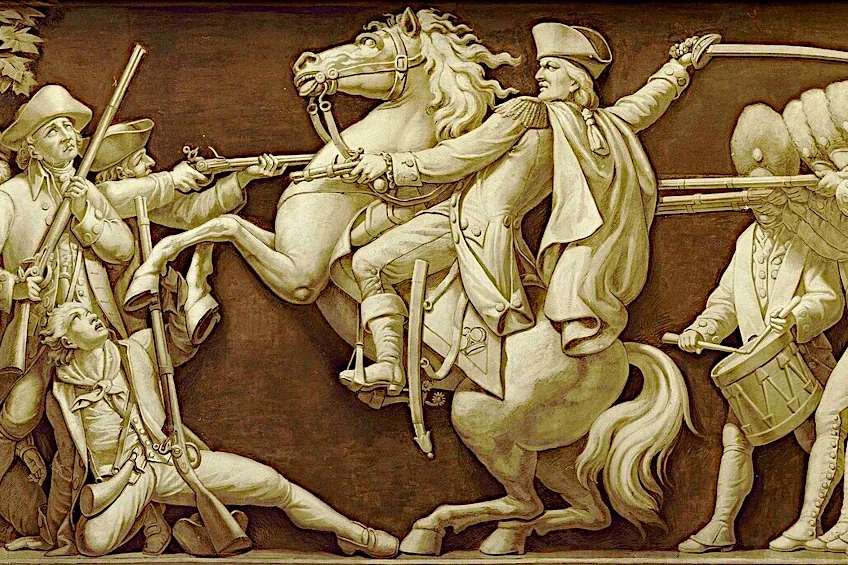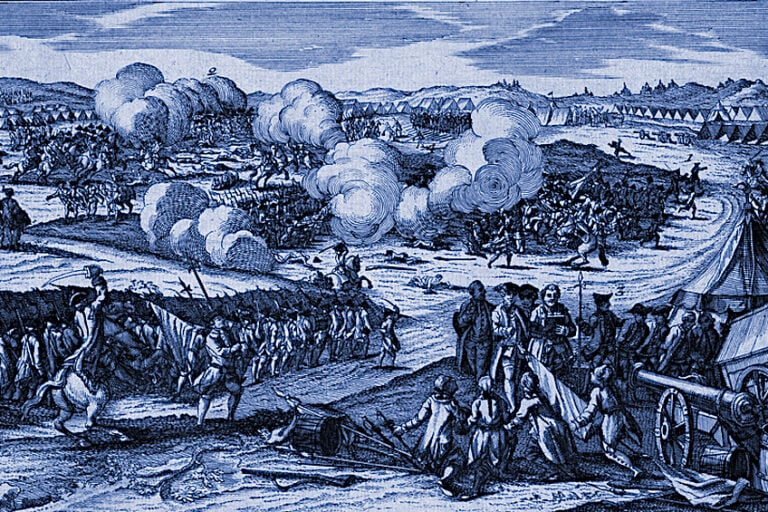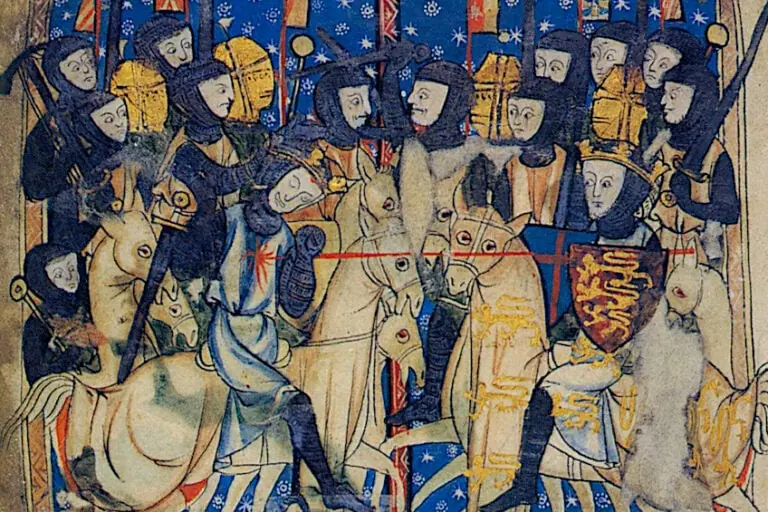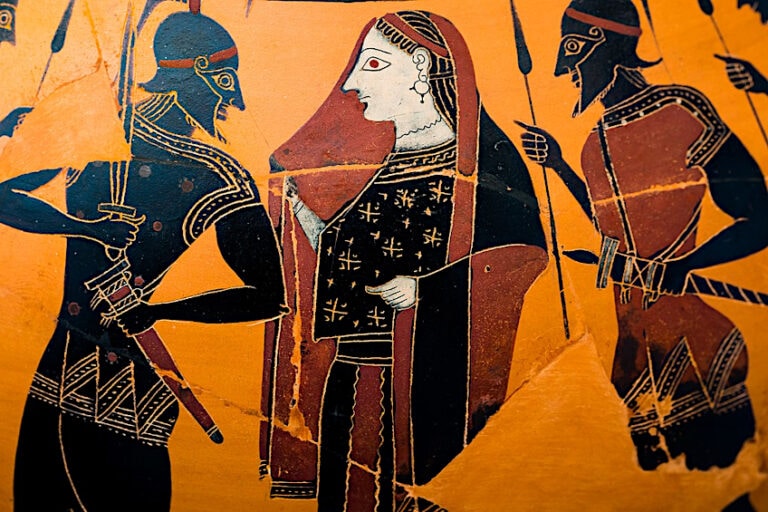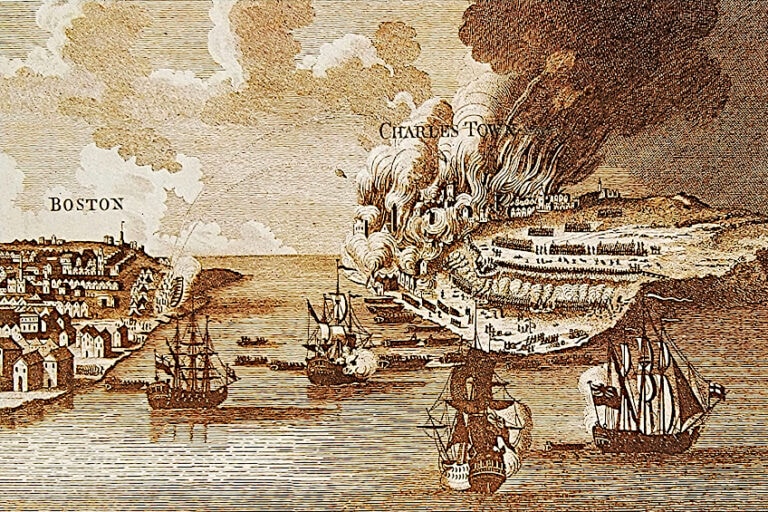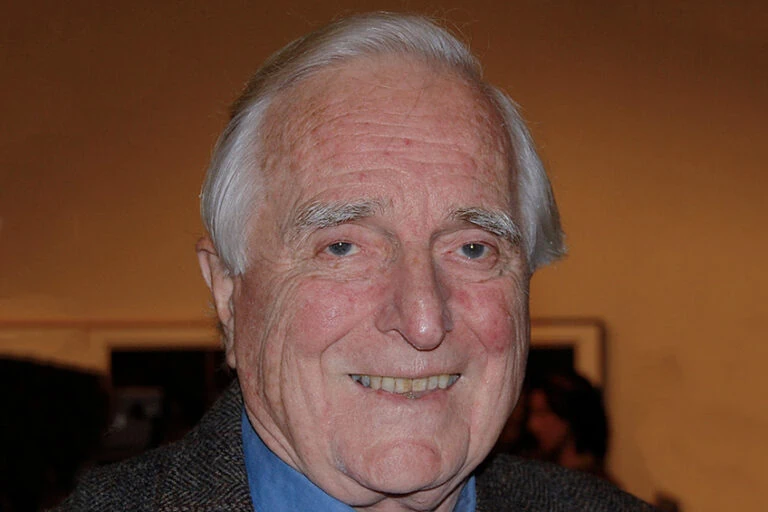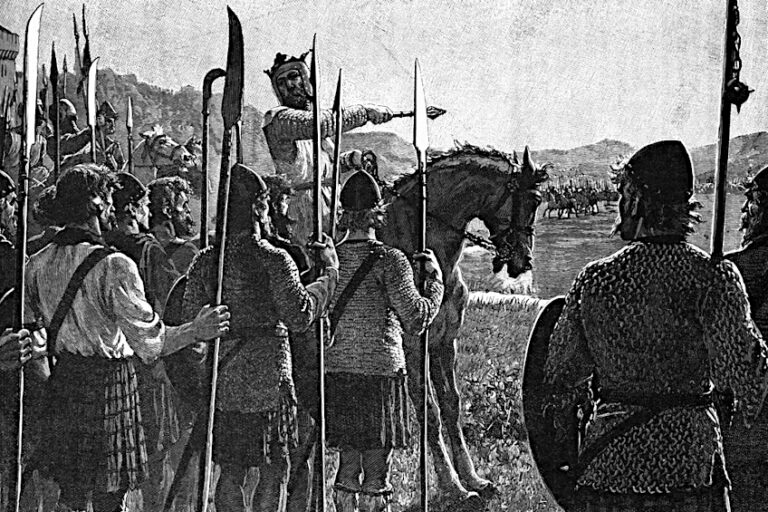Battle of Lexington and Concord – Dawn of the American Revolution
Why was the Battle of Lexington and Concord important and who won the Battle of Lexington and Concord in the end? This is regarded as a particularly significant battle as it was the very first to take place in the American Revolution. It witnessed the colonists in Massachusetts stand up to the British authority, where they famously outfought the notorious Redcoats. Join us as we learn more about this significant moment in American history and address questions such as “where was the Battle of Lexington and Concord?”, and “when was the Battle of Lexington and Concord?”.
Who Won the Battle of Lexington and Concord?
| Name of Battle | Battle of Lexington and Concord |
| Name of Associated War | American Revolution |
| Date of Battle | 19 April 1775 |
| Location | Lexington, Concord, Middlesex |
| Combatants | American and British |
To cut a long story short, the battle was won by the Americans and would be the first of many on their long and arduous road in pursuit of independence from the British authorities. The British troops originally marched straight into Lexington and Concord with the express intention of suppressing the potential of revolt by forcibly seizing the colonists’ firearms. However, their actions had the opposite effect and provoked the American Revolutionary War’s first battle.
The colonists were all connected through a network of individuals who were able to call on local militia groups throughout the region, allowing them to successfully oppose this British threat.
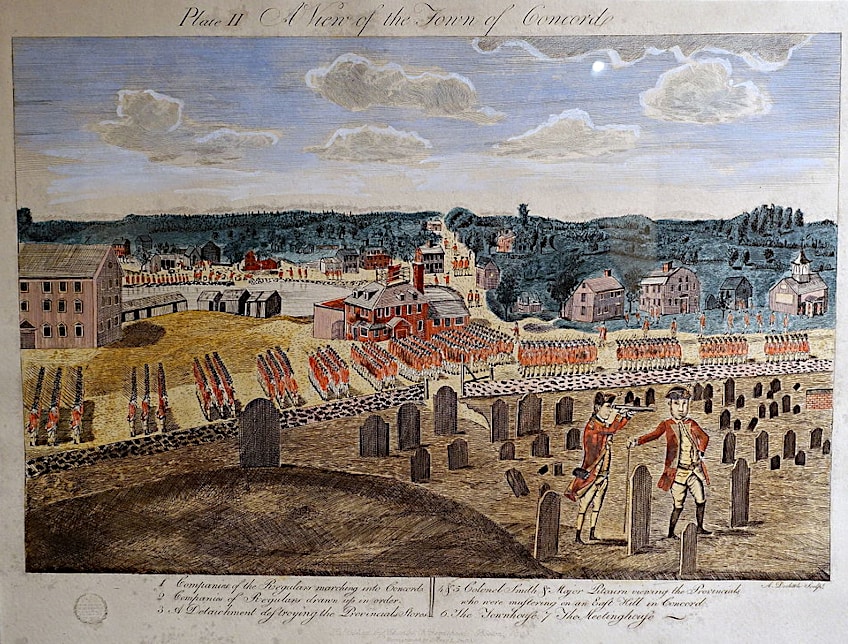 A View of the Town of Concord by Amos Doolittle (1775); Daderot, Public domain, via Wikimedia Commons
A View of the Town of Concord by Amos Doolittle (1775); Daderot, Public domain, via Wikimedia Commons
The Historical Context of the Battle of Lexington and Concord
In 1774, Thomas Gage was named Royal Governor of Massachusetts, and the British Parliament appointed him in charge of quelling mounting dissent resulting from the restrictive British policies. Gage ended up inflaming the existing tension between the colonies and Britain by enforcing British law so harshly. Gage was responsible for writing the Coercive Acts, a set of laws meant to punish colonists for acts of rebellion against the British rulers. By April 1775, he was facing the prospect of an insurrection.
 Cartoon satirizing the Boston Port Bill entitled The Able Doctor or America Swallowing the Bitter Draught (1774); British Museum, Public domain, via Wikimedia Commons
Cartoon satirizing the Boston Port Bill entitled The Able Doctor or America Swallowing the Bitter Draught (1774); British Museum, Public domain, via Wikimedia Commons
He sought to avoid violence by ordering the confiscation of guns and ammunition in Concord, some 20 miles northwest of Boston. But he misjudged the colonists’ bravery and commitment.
Patriot spies had learned of Gage’s scheme. Paul Revere and several other people on horseback sounded the alarm on the 18th of April that the British were making their way to Concord. Early on the 19th of April, Minute Men and militias raced to take them on. Though it is not definitively known which side actually fired first that day, the impact was felt throughout history. After eight years of fighting, those who resisted Gage’s army would pave the way for their eventual independence from British rule.
Causes of the Battle of Lexington and Concord
Now that we have a bit of historical context regarding the battle, we can look at some of the factors that caused the battle to occur. As with any battle, there are various political, economic, and ideological differences between the battling factions. Let’s look at what these various causes were and how they resulted in this famous battle.
Political Factors
The British authorities in America were planning to disarm the colonists by taking their firearms and gunpowder. Many American colonists saw this as an infringement of their right to carry weapons and an encroachment on their right to protect themselves. Many of these colonists were growing more disgruntled with British authority and advocating for greater independence and autonomy. The British were essentially attempting to disarm the colonists as part of a larger campaign to weaken their capacity to oppose British rule.
For several years, tensions between British soldiers and the colonists had been rising, with events such as the Boston Massacre stoking anti-British sentiments among the colonists. The presence of the British in the vicinity of Lexington and Concord heightened tensions.
To protect themselves against future British assault, the colonists formed local militias whose members were known as “minute men”. These militias represented the colonists’ commitment to oppose British tyranny and maintain their liberties.
 US Postage Stamp depicting a member of an American revolutionary militia, known as a minute man commemorating the Lexington-Concord battles; Gwillhickers, Public domain, via Wikimedia Commons
US Postage Stamp depicting a member of an American revolutionary militia, known as a minute man commemorating the Lexington-Concord battles; Gwillhickers, Public domain, via Wikimedia Commons
Economic Factors
The British had put in place a number of laws aimed at controlling colonial commerce and limiting competition from British merchants. This fueled frustration among the Americans, who felt that their livelihoods were being unfairly curtailed through these economically restrictive laws. The local colonists had become used to being financially independent and were more than capable of producing their own commodities. As a result, they became less reliant on products imported from Britain and were less likely to embrace British economic policy.
In addition, the British government was imposing new taxes on the people in the colonies. Many saw these additional taxes as economic exploitation, aimed to drain income from the American colonies for the benefit of the British. The introduction of the stamp act led to the now famous revolt known as the Boston Tea Party.
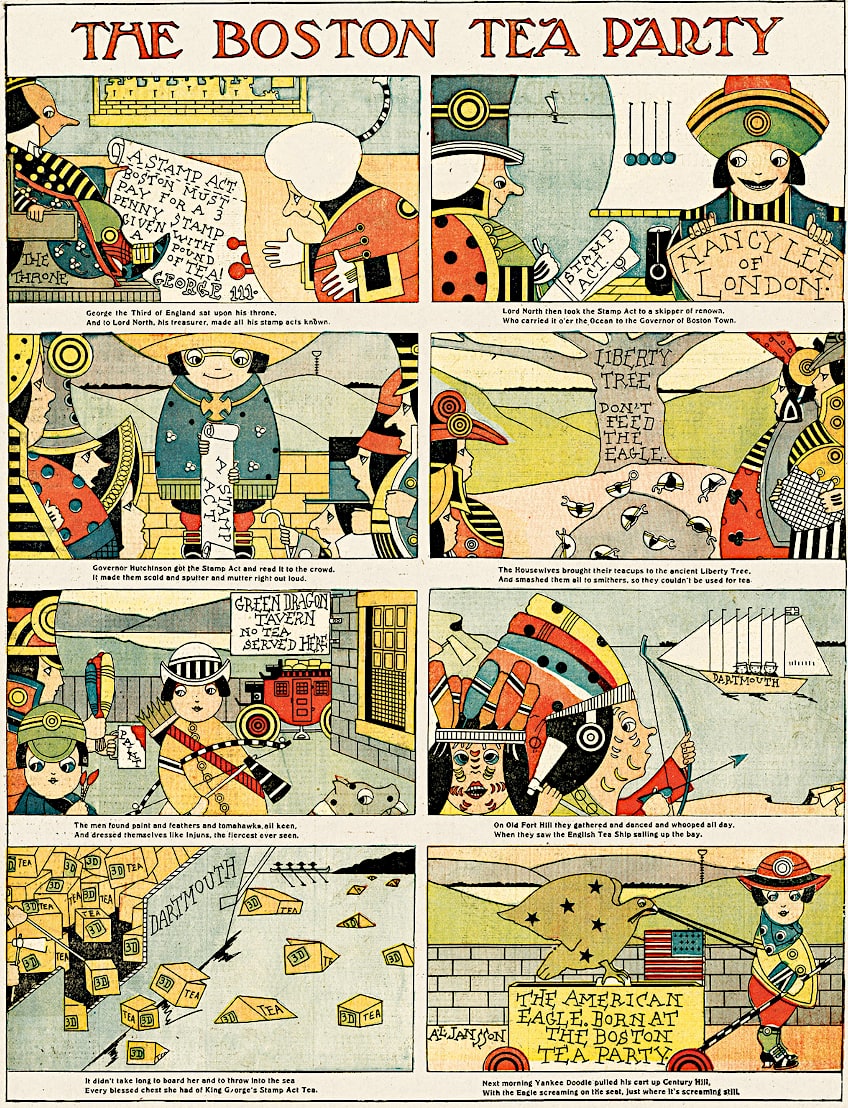 The Boston Tea Party by Augustus L. Jansson (1910); Augustus L. Jansson, Public domain, via Wikimedia Commons
The Boston Tea Party by Augustus L. Jansson (1910); Augustus L. Jansson, Public domain, via Wikimedia Commons
To avoid these British taxes and regulations, many colonists actively engaged in smuggling and other types of illicit trading. This made it impossible for the British administration to properly enforce its policies, which heightened tensions between British officials and the colonists even further.
Ideological Factors
Many colonists believed in republican ideas that stressed civic virtue and popular sovereignty. They felt that authority should be held by the people, not by a king or other ruler. Patriotism and commitment to their villages and colonies were high among the colonists. They viewed themselves as Americans, not just British subjects, and were ready to fight or die for their convictions. Many colonists were likewise opposed to the idea of a monarchy, seeing it as a symbol of imperial oppression.
They were especially critical of King George III’s behavior, which they considered arrogant and despotic.
 Portrait of King George III by an unknown artist from the studio of Allan Ramsay (c. 1770); National Trust, Public domain, via Wikimedia Commons
Portrait of King George III by an unknown artist from the studio of Allan Ramsay (c. 1770); National Trust, Public domain, via Wikimedia Commons
The Battle of Lexington and Concord
Lt. Col. Francis Smith of the British army gathered his force of 700 soldiers to retrieve and destroy military materials purportedly secreted by the Massachusetts militia near Concord. On the evening of the 18th of April, just as the King’s forces were leaving Boston for Concord, anti-British intelligence promptly alerted Dr. Joseph Warren of their plans. Warren dispatched horsemen William Dawes and Paul Revere to spread the word.
Before the Battle
Revere took the short water path from Boston to Charlestown across the bay, while Dawes rode out over Boston Neck. AT approximately 10:00 p.m., the two riders left Boston. At the same moment, two lamps briefly flickered from the Old North Church tower, a pre-planned signal devised by Revere to notify the entire network that the British were going to paddle across the Boston bay rather than march out across the Neck.
Revere mounted and began to ride toward Lexington from the Charlestown shoreline. As he made his way through Somerville, Medford, and Menotomy, additional riders joined him, guns fired, and church bells rang, all alerting the entire countryside of the impending threat.
 Midnight Ride of Paul Revere by Grant Wood (1931); Grant Wood, Public domain, via Wikimedia Commons
Midnight Ride of Paul Revere by Grant Wood (1931); Grant Wood, Public domain, via Wikimedia Commons
The Minute Men took up their guns and made their way to the town greens, closely followed by the remainder of the militia. Word of their invasion had already reached Concord by the time the British arrived.
During the Battle
On the 19th of April, at around 5:00 a.m. in the morning, British forces marched into Lexington, only to be met by a militia company of more than 70 individuals headed by Capt. John Parker. When the British began to rush at them across the green, Parker ordered his troops to withdraw. At some time, a shot was heard, and the frightened British troops fired their guns, killing seven and severely injuring one of the militiamen. The British column advanced on Concord, leaving behind those that were wounded or dying.
When the British commanders, John Pitcairn and Francis Smith, arrived in Concord around 8:00 a.m., they ordered several companies, totaling around 220 soldiers, to take their position at the North Bridge across the Concord River and then proceeded another mile to Barrett Farm, where a supply of guns and ammunition was apparently located.
 The Engagement at the North Bridge in Concord by Amos Doolittle (1775); Daderot, Public domain, via Wikimedia Commons
The Engagement at the North Bridge in Concord by Amos Doolittle (1775); Daderot, Public domain, via Wikimedia Commons
A growing number of militia from Concord and the neighboring towns congregate on the highland, where they could make out smoke rising from Concord. The militia advanced, mistakenly believing the Redcoats had torched the town. The British soldiers, startled by the Minute Men’s numbers and methodical progress, leave to the other bank and prepared to defend themselves as the men marched down the hill. When one unit approached, the Redcoats opened fire, killing Isaac Davis as well as Abner Hosmer. The Minute Men answered by killing three British troops and injuring nine more.
This salvo was immortalized by the poet Ralph Waldo Emerson in his poem Concord Hymn as “the shot heard around the world”, and it caused the British forces to withdraw back to town. Pitcairn and Smith ordered a return to Boston, which quickly devolved into an overwhelming victory as groups of Minute Men attack the British soldiers from all sides along what has since been known as Battle Road.
When Parker’s troops arrive in Lexington, they exacted their retribution for the morning’s carnage by shooting at the British soldiers from cover. The British were constantly attacked by Minute Men who were shooting from behind woods, rock walls, and houses over the next 12 kilometers. British troops arrived on Lexington’s eastern outskirts, but the Minute Men chased them as they returned to Boston.
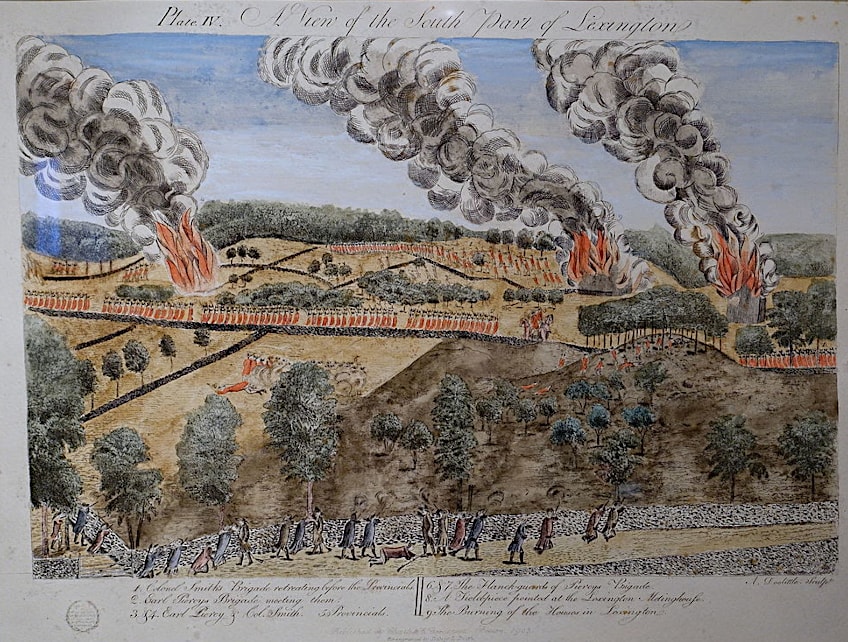 A View of the South Part of Lexington by Amos Doolittle (1775); Daderot, Public domain, via Wikimedia Commons
A View of the South Part of Lexington by Amos Doolittle (1775); Daderot, Public domain, via Wikimedia Commons
The Aftermath of the Battle of Lexington and Concord
The British battled on foot until they reached the protection of British guns on ships stationed in the rivers surrounding Boston. The Patriots pursued them but eventually, let them go due to a lack of clear orders. Following the events of the Battle of Lexington and Concord, Governor Gage suddenly found himself faced with a massive militia of men assembled from all around New England to fight for independence. This tenacious corps of 20,000 men would come to constitute a part of the Continental Army.
The Battle of Lexington and Concord effectively marked the start of a multi-year military war between the colonies and the British rulers.
Following the battle, British soldiers were forced to retire to Boston, suffering severe casualties. This was a huge victory for the colonial soldiers, and it aided in raising support for the independence movement. The conflict resulted in the increased mobilization of the colonials and opposition to British control. Across the colonies, local militias were organized, and colonists started to prepare themselves for armed war. Following the conflict, the British administration sought to quell the colonial insurrection. This included the Prohibitory Act, which prohibited all trade between Britain and the colonists, as well as the acquisition of thousands of Germans to battle against the colonists. The conflict enhanced awareness of the colonial cause throughout Europe, leading to increased support from Spain, France, and other countries.
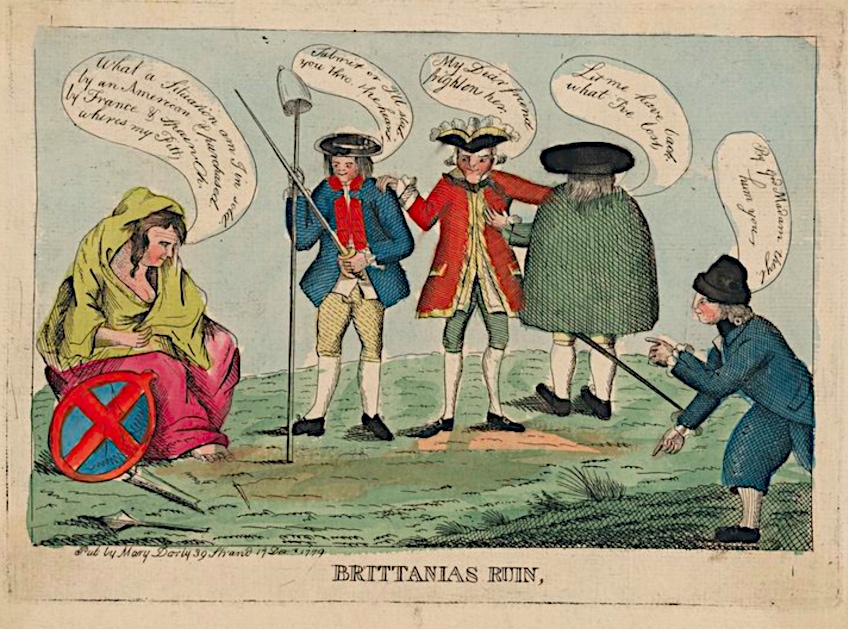 Cartoon depicting Spain, France, and the Dutch turning against Britain titled Britannia’s Ruin (1779); British Cartoon Prints Collection, Public domain, via Wikimedia Commons
Cartoon depicting Spain, France, and the Dutch turning against Britain titled Britannia’s Ruin (1779); British Cartoon Prints Collection, Public domain, via Wikimedia Commons
In total, there were a recorded 393 combined casualties from both the British and Colonial troops. The Colonials suffered 93 casualties in total, with 49 of those being killed and another 39 badly wounded during the battle. A further five people were also recorded as either captured or missing in battle. The British troops suffered 300 casualties in comparison. It was recorded that 73 British soldiers lost their lives during the battle, and a further 174 were badly wounded. Around 53 additional British soldiers were recorded as either captured or missing.
Consequences of the Battle of Lexington and Concord
The battle would ultimately have significant consequences for both sides. For the Americans, it marked the start of their struggle for liberty, and for the British, it marked a serious chink in their armor that revealed that the monarchy was not without its weaknesses and vulnerabilities. The Americans experienced increased unity among the colonies and the conflict served to unify the colonies against a common foe and bolstered sympathy for the independence movement.
After the battle, the Continental Congress authorized the establishment of the Continental Army, which would end up playing a vital part in the American Revolutionary War.
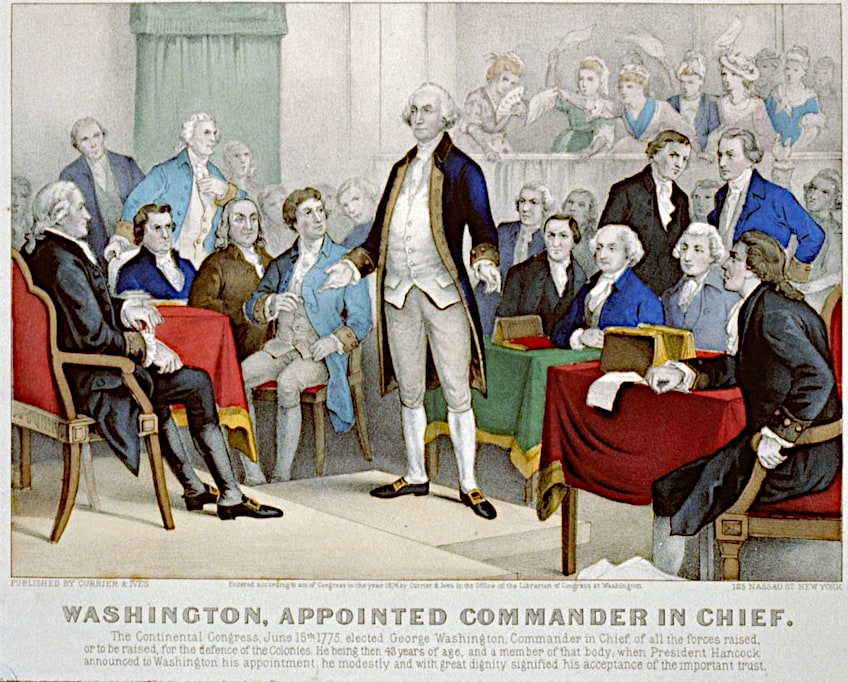 George Washington’s appointment as commander in chief of the Continental Army on 16 June 1775 by an unknown artist (c. 1876); Currier and Ives, Public domain, via Wikimedia Commons
George Washington’s appointment as commander in chief of the Continental Army on 16 June 1775 by an unknown artist (c. 1876); Currier and Ives, Public domain, via Wikimedia Commons
The British were also experiencing their fair share of consequences following the battle. The Battle of Lexington and Concord marked the start of a protracted war for control of the colonies in America, which the British would eventually lose. The conflict reinforced hostility to British control, both in the American colonies and back in the United Kingdom. The fight drew Spain and France into the struggle, which would eventually lead to a worldwide war between these two countries and the British.
Many British citizens were skeptical of the way the government had dealt with the colonials, and no longer wanted to support British rule as a result of the battle.
Historical Impact
The Battle of Lexington and Concord, along with multiple other such uprisings that led up to the American Revolutionary War, would ultimately inspire the creation of the Declaration of Independence, which proclaimed that the United States was an independent nation. The conflict, and the American Revolution as a whole, led to the formation of American traditions and culture, as well as to the emergence of American identity and patriotism.
The events leading up to the Revolutionary War and the foundation of the United States as a new nation had a considerable effect on other international independence movements, such as the Latin American Wars of Independence and the French Revolution.
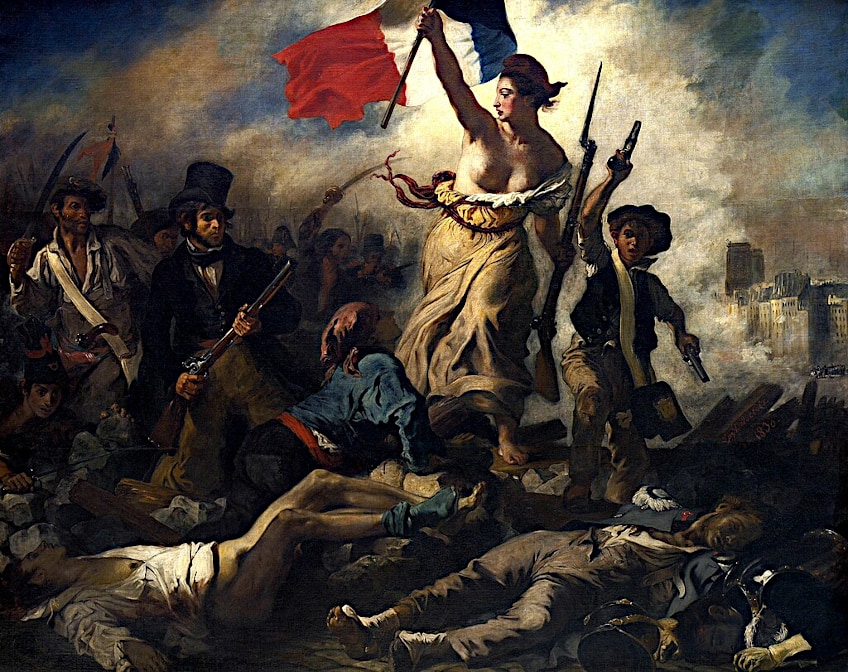 Liberty Leading the People by Eugène Delacroix (1830); Eugène Delacroix, Public domain, via Wikimedia Commons
Liberty Leading the People by Eugène Delacroix (1830); Eugène Delacroix, Public domain, via Wikimedia Commons
The Battle of Lexington and Concord signaled the start of a long war for independence, and it contributed to the establishment of the ideas of democracy, liberty, and self-determination that continue to characterize American culture today.
Long-Term Effects
The right to carry arms was seen as a natural right and an essential measure of self-defense at the time of the battle. The Second Amendment, which guarantees citizens the right to keep and bear weapons, was not passed until 1791, some years after the American Revolutionary War ended.
The Battle of Lexington and Concord, though, influenced American beliefs regarding the right to carry arms and the role of guns in American culture. The right to carry weapons was considered by the American colonists as a means of self-protection against tyranny as well as a symbol of their self-reliance.
 Protesters at a gun rights rally in Virginia (2020); Anthony Crider, CC BY 2.0, via Wikimedia Commons
Protesters at a gun rights rally in Virginia (2020); Anthony Crider, CC BY 2.0, via Wikimedia Commons
This mindset would have a long-term impact on American society and politics. The right to possess weapons is now guaranteed by the Second Amendment to the United States Constitution, which has been the topic of much discussion and controversy in recent years. Numerous legislative battles and cases in court have focused on the meaning and implementation of the Second Amendment, with proponents on both sides of the dispute trying to find the appropriate balance between public safety and the individual rights of citizens.
The Legacy of the Battle of Lexington and Concord
As it was the first battle of the American Revolutionary War, it was critical to the early American administration that the perception of British condemnation and American innocence be preserved. For decades, the history of the Patriot’s preparations, their information-gathering techniques, utilization of warning signals, and doubt regarding the first shot was rarely recounted in public. The account of the injured British soldier, for example, who was scalped with a hatchet by a Minuteman at the North Bridge, was heavily suppressed. Statements detailing some of these events were not publicized and were returned to those who took part (Paul Revere was a notable example).
During the early 19th century, the debate about who was to blame intensified. For instance, senior participants’ testimony on Lexington and Concord in later life differed significantly from their statements given under oath in 1775.
All now agreed that the British shot first at Lexington, although they weren’t sure 50 years before. They all stated that they fired back now, but in 1775, they said few did. In the American mind, the battle grew to almost mythical heights. Legend took precedence over fact. At some point, there was a major shift in the way events were portrayed, and the Patriots were presented as actively battling for their cause, instead of trying to defend themselves as helpless victims. Paintings depicting the Lexington conflict started to depict the militia and colonials fighting back in defiance of the British.
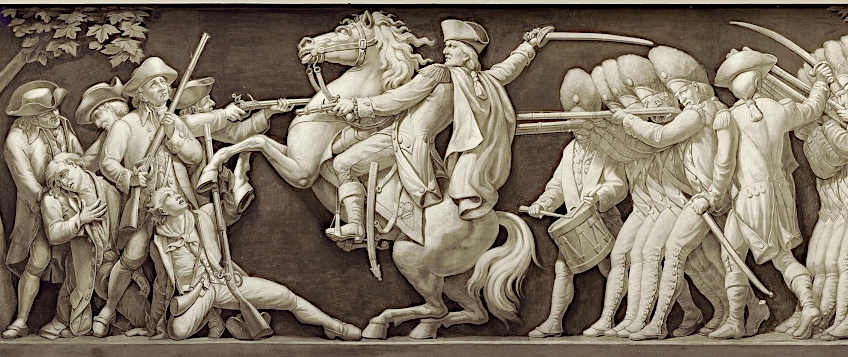 Detail from the painted frieze on the Capitol Rotunda depicting the Battle of Lexington and Concord by Allyn Cox and Filippo Costaggini (1877); USCapitol, Public domain, via Wikimedia Commons
Detail from the painted frieze on the Capitol Rotunda depicting the Battle of Lexington and Concord by Allyn Cox and Filippo Costaggini (1877); USCapitol, Public domain, via Wikimedia Commons
The events at the North Bridge were commemorated in Ralph Waldo Emerson’s Concord Hymn in 1837. It became significant because it honored the start of the American Revolution, and it served as a way for Americans in the 19th century to learn about the Revolutionary War in America, helping to shape the nation’s identity. Many generations of Americans studied Paul Revere’s Ride, the epic poem by Henry Wadsworth Longfellow after 1860. It is historically inaccurate, though – for instance, Paul Revere never made it all the way to Concord – yet it embodies the concept that one person may influence the course of history.
That concludes our look at this significant battle in American history. This was a particularly important battle, as it signaled the beginning of the Revolutionary War that would ultimately result in America’s independence from British rule. The battle left a lasting legacy in the States, with many paintings made and poems written in honor of this momentous event.
Frequently Asked Questions
Where Was the Battle of Lexington and Concord?
The battle took place across several towns in Massachusetts. These towns included Lexington, Concord, Menotomy, Lincoln, and Cambridge. Both Concord and Lexington are located about 20 miles from Boston.
When Was the Battle of Lexington and Concord?
The battle occurred throughout various towns in Massachusetts on the 19th of April, 1775. It was in Lexington in the early hours of the morning that the first shots were heard. After the Lexington confrontations, the British then proceeded to Concord. The fight raged on all day, with British troops fleeing to Boston and being attacked by American militias along the route back.
Why Was the Battle of Lexington and Concord Important to Early American History?
The Battle of Lexington and Concord began the military confrontation between British armies and colonists seeking their autonomy from British authority. Many Americans were inspired to join the struggle against British rule after the Lexington conflict and the following confrontations at Concord and along the British retreat to Boston. Following the conflict, the Second Continental Congress authorized the establishment of a Continental Army, with George Washington named commander-in-chief. American militiamen effectively hampered British forces using their knowledge of the terrain and skill with guerrilla tactics, demonstrating that the colonists were capable of competing with the British on the battlefield.

I am deeply passionate about history and am constantly fascinated by the rich and complex stories of the past. As the editor-in-chief of learning-history.com, I have the opportunity to share this passion with a wide audience through the creation and distribution of engaging and informative content about historical events, persons, and cultures. Whether it’s through writing articles and blog posts or creating videos or podcasts, I strive to bring the past to life in a way that is both accurate and enjoyable. My expertise in history, combined with my strong writing and communication skills, allows me to effectively communicate complex historical concepts and make them accessible and interesting to a wide range of readers. I am truly grateful for the opportunity to share my love of history with others through my work on learning-history.com.

